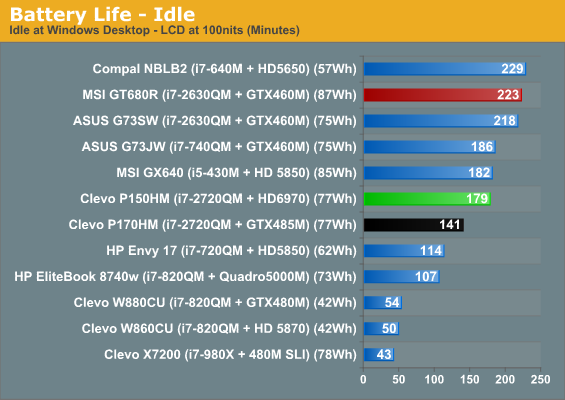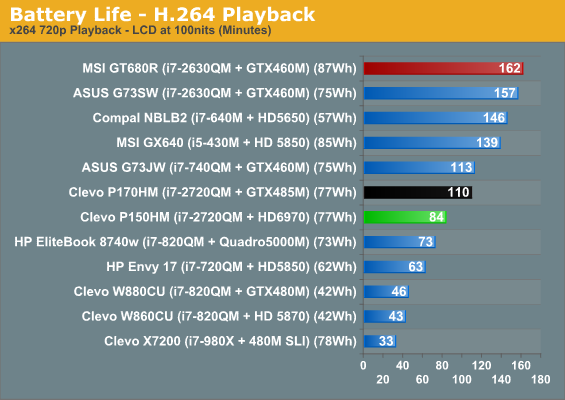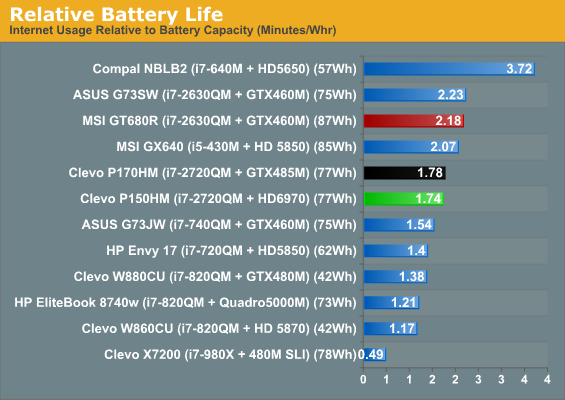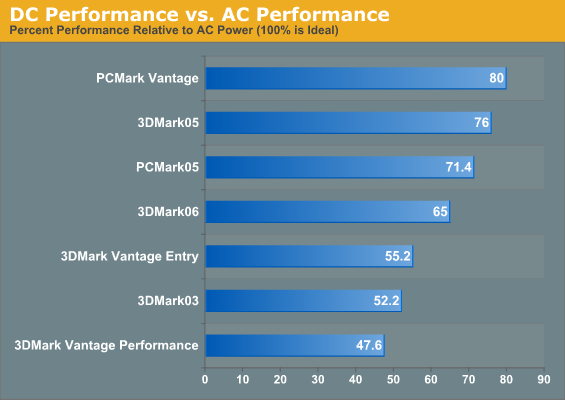Eurocom Racer: Why the Radeon HD 6970M Rocks
by Jarred Walton on March 17, 2011 3:00 AM ESTBattery Life and Power: For Better and for Worse
This much we know: with high performance comes high power requirements and low battery life. The Racer has a quad-core Sandy Bridge processor coupled to the second fastest single-chip mobile GPU. We’ve seen Sandy Bridge hit idle power requirements of as little as 10W for a 17.3” chassis, but that was without a discrete GPU. Our informal calculations suggest that NVIDIA’s GTX 460M requires about 10W of power, which would mean best-case you’d get half the battery life out of a notebook compared to IGP (or switchable graphics). We also know from the reviews of HD 5870 notebooks that AMD’s previous generation top GPU typically required more power than the NVIDIA competition. With 6970M we get some changes, but it’s not going to be superior in every way. Let’s start with battery life.




When we tested the P170HM with GTX 485M, we measured best-case idle battery life of 141 minutes, Internet battery life of 137 minutes (only slightly lower), and H.264 decoding battery life of 110 minutes. Since it has a larger 17.3” LCD and an SSD plus hybrid HDD, we can reasonably assume it’s going to require slightly more power, so the P150HM should have better battery life—assuming the 6970M uses the same amount of power as the 485M. Both notebooks are using the same size 77Wh battery, so we can compare the results directly. The ASUS G73 series has a very slightly smaller battery, but it’s close enough that we’ll just look at the total minutes there as well.
What we find is that the P150HM enjoys a healthy lead over the 485M at idle, providing 27% more battery life. However, in both our Internet and H.264 playback tests, it looks like the 6970M is using a lot more power than the 485M. The P170HM only provides a few minutes more battery life in the Internet test, but again the presence of an extra SSD and a larger LCD mean it’s leading by more than that. The x264 test on the other hand really paints the 6970M in a bad light, with the NVIDIA chip providing 31% more battery life despite the chassis handicap. Downgrade to the 460M with a slightly slower CPU, and the G73SW leads at idle by 22%, in the Internet test that increases slightly to 25%, and in H.264 playback it’s a whopping 87%.
I ran a few additional battery life tests just for good measure. Looping 3DMark06, the battery lasted just 54 minutes before the system shut down—which is still far better than the previous generation Clarksfield W860CU where you’d last that long at idle. (Hooray for higher capacity batteries, Clevo!) If you run the LCD at maximum brightness, idle battery life drops to 158 minutes (so the LCD uses an extra 3.4W at 240 nits compared to 100 nits). Charging time is pretty reasonable for a 77Wh battery, requiring 128 minutes with the system running.
Obviously, you get more performance than 460M with the 6970M and 485M, but more than anything battery life results like these make us pine for the ability to switch between the IGP and dGPU—particularly since the IGP also supports Quick Sync. I’ve encountered glitches with NVIDIA’s Optimus Technology, but mostly those are driver quirks; I’d rather deal with a few quirks if it meant triple the battery life.
Investigating Power
As we did with the ASUS G73SW, we wanted to get an idea of what sort of power requirements the GPU puts on the system. We’ve looked at a quad-core Sandy Bridge setup with an SSD, 17.3” LCD, and no dGPU. By our calculations, that notebook used an amazingly low 9.04W at idle, 10.24W in the Internet test, and 16.38W in H.264 playback. In contrast, even running with the most conservative power settings, the Racer is drawing 25.81W idle, 34.48W Internet, and 55W for H.264 decoding. That latter figure is particularly bad, as the CPU should be able to handle all of the decoding work while using less power than that! While this is merely an estimate, it looks like the 6970M idles at around 16W, jumps to 24-25W for Internet use (with Flash ads present on the test pages), and reaches a high of nearly 40W for H.264 decoding. Yes, DXVA is working as the CPU load was only 2-3%, but at what cost?
We also ran some comparative power draw numbers for the P170HM and P150HM using a Kill-A-Watt meter with the notebooks on AC power. Again, the two notebooks use the same power adapter, so we shouldn’t have to worry about differences in efficiency. Idle power, as indicated by our battery life testing, favors the Racer/6970M: 36W versus 41W. With a high CPU load running Cinebench 11.5, the tables turn and the P170HM required 92W compared to 104W. Gaming switches places again, with the P150HM drawing a maximum of 142W vs. 158W, and with Furmark as a worst-case graphics test we hit 150W on the 6970M compared to 170W with the 485M. If you really want to punish a system by running Furmark with something like x264 encoding (which is what we did), we got the Racer up to 188W versus 211W with the P170HM.
So for the idle and heavy load tests, it looks like the P170HM + GTX 485M consistently requires more power than the P150HM + HD 6970M; however, as the battery tests show, the medium to light loads like Internet browsing and video playback may end up favoring NVIDIA. The reason for this may lie with the GPU clocks on the 6970HM. At idle with the GPU essentially inactive, the core clock is 100MHz and the RAM clock is 150MHz (600MHz effective). That’s fine and is similar to what NVIDIA does with their GPUs; the problem is what happens at intermediate loads. For H.264 decoding via DXVA, the 6970M kicks up to a core clock of 300MHz, but the RAM runs full tilt at 900MHz (3600MHz effective). While surfing the Internet I also saw the GPU clocks periodically increase to 400/900MHz for short intervals before returning to 100/150. At everything other than idle, it appears that the 6970M runs the GDDR5 memory at 3.6GHz. Couple that clock speed to a 256-bit memory interface and the moderate load scenarios really cut into potential battery life.
Contrast that with NVIDIA, where as one example the GTX 460M runs at 50/100MHz core/shader with 135MHz (270MHz effective) on the memory, but the 2D Desktop clocks are 202/405MHz core/shader with 324MHz (648MHz effective) on the memory. It’s only under 3D loads that the RAM will run at the full 1250 (2500) MHz clock speed. NVIDIA also tends to curtail performance while on battery power, so it’s not that their way is always superior; it’s simply different and in many cases appears to improve battery life at the cost of performance. Which brings us to our final power/battery related topic.
Performance on Battery Power
One last chart before we leave the power and battery discussions. With the ASUS G73SW, we showed that on battery power performance is only 23 to 39% of what you get on AC power when “playing games” (we used 3DMark because of repeatability). We ran the same set of tests for the Racer/P150HM. Guess what? It’s proportionately far faster at games than the GTX 460M when you’re on battery power, and presumably the same pattern would hold with the 485M:

Where the worst result on with the GTX 460M was 23% of AC performance in 3DMark Vantage Performance, with the 6970M you still get at least half of your plugged-in performance. Some of the 3DMark releases managed to run at three-fourths of AC performance, which is darn impressive for a beastly mobile GPU rated to draw between 75 and 100W of power. So while you won’t be able to play games for hours on end, at least if your power cord gets kicked out you won’t suddenly get a slideshow. AMD does restrict the GPU clocks while on DC power to 400MHz core (versus the normal 680MHz), but the GPU memory is again allowed to run at the full 900MHz (3.6GHz).










47 Comments
View All Comments
JarredWalton - Thursday, March 17, 2011 - link
Well, the whole notebook is an ES right now, so I can't really make a judgement call one way or the other on the 6970M. If it has an ES GPU, all Eurocom needs to say is, "We sent you a pre-release notebook." (And they already said that before shipping, so we're covered on that front.) This version I received also includes the Cougar Point bug, and if were ordering it right now that would make me pretty angry. Hopefully everything will be sorted out when the product shows up on their actual site, but I wouldn't be shocked if some fishy stuff happened on occasion.I'd also think AMD should have something to say about them shipping ES 6970M cards to customers, at least if they're not supposed to be available yet. What notebooks have shipped with the card to actual customers as opposed to reviewers? To my knowledge, every Clevo Sandy Bridge system is still affected by the Cougar Point bug and should be recalled, so my guess is only the X7200/Phantom 2.0 would be going out to customers.
Windkull - Thursday, March 17, 2011 - link
Jarred,They shipped some ENG samples on X7200s saying that they were not:
http://forum.notebookreview.com/sager-clevo/556994...
That said, I think consensus seemed to be that the ENG samples ran a bit too hot but might actually have more cores unlocked.
Also, Sandy Bridge Clevos have been getting delivered for about a week now, I think they started shipping 10 days ago or so.
JarredWalton - Thursday, March 17, 2011 - link
See update note in the conclusion; thanks for the info!jah1subs - Thursday, March 17, 2011 - link
I see all of this information about so many laptop/notebooks. But how do I know whether or not it has a matte display? My eyes have a problem with glare.JarredWalton - Thursday, March 17, 2011 - link
Most companies will say either "glossy" or "glare type" on the LCD, or "matte" or "anti-glare". In general, though, assume everything is glossy unless otherwise noted... or buy a business laptop, which are usually anti-glare (ThinkPad, Latitude, ProBook, etc.)Ikefu - Thursday, March 17, 2011 - link
So the new Mac book pros use switchable graphics from their AMD gfx cards to the build in Sandy Bridge gpu when unplugged. Why didn't they do that here or at least give you the option?Is there some technical limitation preventing this with a 6970M?
mczak - Thursday, March 17, 2011 - link
that's for sure. With ~10% less clocks and 25% less shader units than the GTX 485M, it ends up just slightly faster than GTX 480M.Though 6950M vs. 470M might be interesting - I'd expect the former to be faster but possibly not that much. It'll also depend on the exact clocks probably as those aren't really fixed for the mobile parts.
Beenthere - Thursday, March 17, 2011 - link
Won't buy any product with InHell inside.5150Joker - Thursday, March 17, 2011 - link
Jarred,Did you leave Physx enabled for the nvidia cards when running Vantage? It would explain why there was such a huge overall score gap.
JarredWalton - Friday, March 18, 2011 - link
Oh... hmmm, yeah, I probably did. I don't know that I've ever shut off PhysX for 3DMark Vantage.